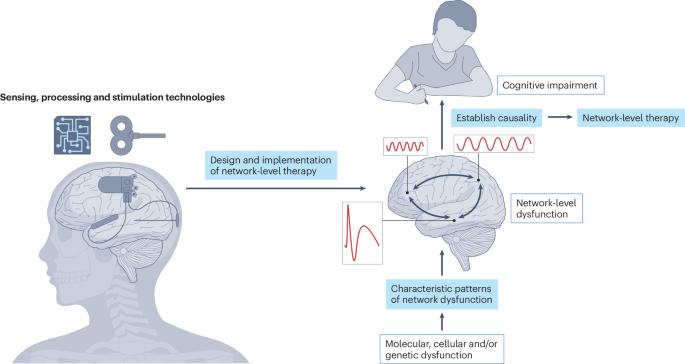Interictal network dysfunction and cognitive impairment in epilepsy
IF 26.7
1区 医学
Q1 NEUROSCIENCES
引用次数: 0
Abstract
Epilepsy is diagnosed when neural networks become capable of generating excessive or hypersynchronous activity patterns that result in observable seizures. In many cases, epilepsy is associated with cognitive comorbidities that persist between seizures and negatively impact quality of life. Dysregulation of the coordinated physiological network interactions that are required for cognitive function has been implicated in mediating these enduring symptoms, but the causal mechanisms are often elusive. Here, we provide an overview of neural network abnormalities with the potential to contribute to cognitive dysfunction in epilepsy. We examine these pathological interactions across spatial and temporal scales, additionally highlighting the dynamics that arise in response to the brain’s intrinsic capacity for plasticity. Understanding these processes will facilitate development of network-level interventions to address cognitive comorbidities that remain undertreated by currently available epilepsy therapeutics. Epilepsy is often associated with cognitive comorbidities that lack effective treatment options. In this Review, Gelinas and Khodagholy discuss how physiological neural networks involved in cognition are dysregulated in epilepsy and the therapeutic potential of network-level interventions.


癫痫的间期网络功能障碍与认知障碍
当神经网络能够产生过度或超同步的活动模式,从而导致可观察到的癫痫发作时,就可以诊断为癫痫。在许多情况下,癫痫与认知合并症有关,这些合并症在癫痫发作和对生活质量产生负面影响之间持续存在。认知功能所需的协调生理网络相互作用的失调与介导这些持久症状有关,但其因果机制往往难以捉摸。在这里,我们提供的神经网络异常与潜在的贡献认知功能障碍癫痫的概述。我们在空间和时间尺度上研究了这些病理相互作用,另外强调了大脑内在可塑性能力所产生的动态反应。了解这些过程将有助于开发网络层面的干预措施,以解决目前可用的癫痫治疗方法仍未充分治疗的认知合并症。
本文章由计算机程序翻译,如有差异,请以英文原文为准。
求助全文
约1分钟内获得全文
求助全文
来源期刊

Nature Reviews Neuroscience
NEUROSCIENCES-
自引率
0.60%
发文量
104
期刊介绍:
Nature Reviews Neuroscience is a multidisciplinary journal that covers various fields within neuroscience, aiming to offer a comprehensive understanding of the structure and function of the central nervous system. Advances in molecular, developmental, and cognitive neuroscience, facilitated by powerful experimental techniques and theoretical approaches, have made enduring neurobiological questions more accessible. Nature Reviews Neuroscience serves as a reliable and accessible resource, addressing the breadth and depth of modern neuroscience. It acts as an authoritative and engaging reference for scientists interested in all aspects of neuroscience.
 求助内容:
求助内容: 应助结果提醒方式:
应助结果提醒方式:


